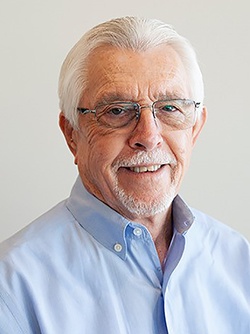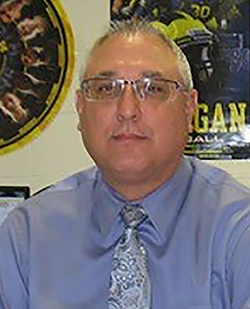
Please provide an overview of your time in the pupil transportation industry.

Steven A. Simmons III: I’ve been in the pupil transportation industry for about 42 years. I started out as a mechanic working for a private contractor in Columbus, Ohio and then applied and got a job with the school district. I worked my way up from various shift jobs as a mechanic until eventually I became director of transportation for Columbus City Schools. It was interesting because I had a wonderful superintendent who hired me, Dr. Gene Harris. She believed and supported everything I was trying to do, and it worked out very well. What helped a great deal was I’d held virtually every position all the way up from mechanic to fleet supervisor, to operation supervisor, dispatcher, and router. I’d done everything and learned every step of the way and loved it
For me, hands on experience has been very important. When things went wrong, I usually knew what could be done to remedy it, or to deflect many issues before they became problems. For example, if a driver said, “my transmission is overheating”, my background enabled me to get to the crux of the matter quickly.
In 2009 I went to Louisville for my first NAPT conference. As transportation director in Columbus, I served on quite a few local and state boards and participated in a lot of events, but the NAPT conference experience was different in that I got to meet peers from around the country. I was impressed at the strong focus on improving school bus safety and professional development. Everything had the sharp focus on what we all did in common—transport children to and from school safely and conveniently. You shared challenges with others and learned from those who already experienced the same and figured out solutions. Again, I loved it. NAPT is an insanely good resource for questions and answers about how to make your operation safer and better.
Getting involved on the Board of NAPT was a natural for my career progression. I was fortunate to have a fantastic mentor, former NAPT president and Hall of Famer, the late, great Don Carnahan. He was just a wonderful man. He helped me chart the course that led me to where I am today. I’ve been proud to serve as NAPT President the last two years and for the friendship and support of my colleagues.

Dwight Gleaves: I’ve been working with school transportation professionals for more than 30 years. My first trade show experience was at the Texas APT conference in 1995, and a good friend of mine convinced me that I should also attend the NAPT conference that year. His name was Joe Glover, and he was very active in NAPT at the time. So, I headed off to Orlando for my first experience where I made many personal and professional friendships that continue to this day.
When NAPT created the affiliate member director position I thought it would be interesting to give it a try. I was elected to the position in 2014 and it’s been an absolutely wonderful eight years being on the board. Like Steve, I also had the pleasure of knowing and serving with Don Carnahan who mentored me when I joined the Board. And later serving with Keith Henry, Barry Sudduth, and Steve Simmons. Being a vendor serving the needs of pupil transportation and NAPT Board member has been a wonderful experience and a major focus of my career.

Brad Aemisegger: I came into student transportation after driving a school bus while I was attending college. The schedule fit, and I fell in love with the job. When a frontline supervisor position opened up, I was hired as the a.m. dispatcher. Mornings started very early, 4:00-4:30 a.m., but you got off early in the afternoon which allowed me to play some golf on the one or two days a year when it’s warm enough in Northwest Ohio!
I rose through the ranks much like Steve, gaining operational experience every step of the way, and moving up when I had the opportunity. When I eventually became transportation director, I became actively involved in the Ohio Association for Pupil Transportation. Committee work, region board reprehensive and finally working my way through the officer ranks. I eventually became president of the organization, which helped me expand my network and enabled me to work with my counterparts in other states. That work lead me to NAPT.
Like Steve, I enjoyed getting involved in an organization that understood student transportation. So, when the opportunity came, I ran for NAPT Region 3 director and was fortunate enough to win the election.
I don’t know exactly how many years I’ve been on the NAPT Board – I think it’s five or six – but I can tell you it has definitely broadened my thinking and experience not just in student transportation but all the facets of K-12 education. It’s amazing how every state does things just a little bit differently.
So, in a nutshell, that’s how I got involved in school transportation. I was in the right place at the right time more than once. And once you realize that you can make a positive difference in the lives of children you want to do it more and more – you kind of become addicted to it. Gratifying is the word that comes to mind.
What do you think were the association’s greatest accomplishments during your time on the Board?’
Simmons: I’d say that NAPT survived this pandemic. We learned from challenges we’d never faced before and came out stronger because we faced them. And I think we have accomplished a lot too, during a very difficult national storm affecting every corner of our economy.
In just the last two years, we offered more than 100 webinars, created an online platform so people can access them any time they want and are now going to take the show on the road. We also started a brand new magazine that’s delivering strong content and we’ve integrated it with our electronic newsletter, which gives our business partners a whole range of new opportunities to connect with the rest of our members. We also launched the NAPT Collaborative, which is going to give us a variety of entirely new opportunities to collaborate and partner with other k-12 and private sector organizations. Taken together, I’d say we’ve grown the organization’s effectiveness by broadening the scope of our communications, professional development—everything—a LOT, and did so during very trying times. I’m proud of all of it, and want to thank the board and NAPT staff for all we’ve accomplished as a team.
Gleaves: I’m proud of my eight years on the NAPT Board and the significant accomplishments we’ve made as a team. The pandemic initially did hamstring what we tried to accomplish, including preventing the annual trade show. But we re-thought everything and adapted successfully by innovating to face the reality of circumstances. It was hard on vendors not to be able to show our wares in a face-to-face setting. But through NAPT ACTS! we were able to quickly shift gears and do what we do in Texas where I live—pick yourself up, dust yourself off, and get back on the horse again! My take-away is the list of accomplishments in the face of a daunting challenge. What an honor to be associated with such a great organization.
Aemisegger: What I like about NAPT is that it’s focused on safe, reliable, and convenient student transportation. We never lose sight of that or go off on tangents. We try to be nimble and able to react effectively to situations that we might not expect. When COVID hit, there was no model, no path we could follow. So we just said, Hey, let’s be the frontrunner pushing out the latest information to our members and the entire yellow bus industry. When we conducted interviews, in-service training, webinars, created new publications it wasn’t just for members; we shared it with everyone because we chose to lead and innovate for the benefit of the industry. That’s who we are and I’m proud of the course we set.
I think what it comes down to is NAPT requires you to think big picture, nationally and even globally, to influence legislation and other national policy for the good of the industry. So, for me, that’s a great accomplishment.

What were the biggest changes you saw over the years you served?
Simmons: There have been so many changes. But the changing nature of our power source – vehicle propulsion, as Mike calls it – has to be right up there. For example, the industry has gone from using gasoline powered engines to diesel power, back to gasoline, back to diesel, then to clean diesel engines, with a little liquid propane and CNG mixed in. Now we’re going to be all electric. I’d have never in 100 years thought we would just talk about electric school buses. Not demonstration programs but going full electric by a target date that is a single digit number of years away. What a cycle, especially when you’re trying to develop and manage a fleet of buses! But through it all we’ve tried to be flexible and adapt as quickly as possible.
Gleaves: There have been so many changes and probably the biggest change is the technology now in school buses. Speaking from my business interest—oil and lubrication—not too long ago there were just two different types of oil—detergent and non-detergent. Today there are many choices, including a selection of synthetics. Technology is growing exponentially and NAPT has really tried to highlight it all.
Aemisegger: I’ve been in the industry 36 years and would agree with Steve and Dwight that the biggest change is technology. And I would include technology both in administration of the system and on the actual school bus. You think back 40 years ago what the interior of a school bus looked like and how it was designed. Now you look at all that’s new in the bus itself and the operations that run the buses. It’s profound! I’ve been around long enough to remember when we first started to route students, it was literally with colored pins and string laying out a route. Now routing is done electronically, and we can track the buses with GPS. Those two areas are probably the biggest changes I’ve seen.
In the coming years, on which issues or initiatives do you think the industry should focus?
Simmons: We just finished four sessions developing a new strategic plan for NAPT. It was an interesting and exciting process that included a lot of fresh ideas and vision. It’s going to continue to propel NAPT on its leadership trajectory of understanding societal change, embracing its reality, and crafting solid solutions for our industry and the children and parents we serve. One important new development will be the NAPT Collaborative to innovate and help us lead the charge. Stay tuned!
Gleaves: I think NAPT should continue with their strategic plan and continue to grow with their educational programs, ACTS! and the Road Show approach to in-person meeting at a time when these meetings must be smaller to meet state and federal Covid guidelines. And of course, eventually the larger face-to-face conference that, keeping our fingers crossed, will take place in ’22. So, stay the course, continue embracing new technology and positioning the organization as the leader of a great industry.
Aemisegger: One thing I’d like to mention specifically is the driver shortage, or as Mike calls it, “the shortage of CDL license holders that are able and willing to drive a school bus.” It’s always been an issue that had to be managed, but it wasn’t something that affected your day-to-day operation to the extent it does today.
It was usually, hey, there’s light at the end of the tunnel and we’ll have somebody on board in a month. Now, there is no light. The individual you’d look to hire back in the day are not there anymore, at least in the quantity you need. So, the challenge for the industry is what is the future for the yellow school bus and its role transporting students?
There is a fledgling but growing demand from the parents in the community for something different, something even more convenient. So, what will school transportation look like, say, five years down the road? I am not sure but it’s probably going to be significantly different in many ways. Will we start running smaller, more nimble vehicles, some of which may not be buses, or are we going to continue to operate a large bus that holds 40, 50, 60 kids and is powered by an entirely different engine, which means we must turn over the entire fleet? It’s interesting, and kind of exciting but scary as heck too. It’s gratifying to know we have NAPT involved in this conversation, prepared to lead it when necessary, and thinking about other emerging trends too.


